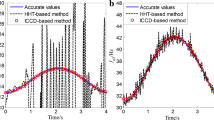Abstract
Linear cyclic systems (LCS’s) are a class of systems whose dynamic behavior changes periodically. Such a cyclic behavior is ubiquitous in systems with fundamentally repetitive motion. Yet, the knowledge of the noise and vibration transmission paths in LCS’s is quite limited due to the time-varying nature of their dynamics. The first part of this two-part paper derives a generic expression that describes how the noise and/or vibration are transmitted between two (or multiple) points in the LCS’s. In Part II, experimental validation of the theoretical development of Part I is provided. The noise and vibration transmission paths of the scroll and rotary compressors (two typical LCS’s) are examined to show that the LCS’s indeed generate a series of amplitude modulated input signals at the output, where the carrier frequencies are harmonic multiples of the LCS’ fundamental frequency. The criterion proposed in Part I to determine how well a given LCS can be approximated as a linear time-invariant systems (LTIS) is applied to the noise and vibration transmission paths of the two compressors. Furthermore, the implications of the experimental validations/applications are discussed in order to assess the applicability of the noise/vibration source and transmission path identification techniques based on the assumption that the system under consideration is linear and time-invariant.
Similar content being viewed by others
References
Barker, R. W. and Hinich, M. J,, 1994, “Statistical Monitoring of Rotating Machinery by Cumulant Spectral Analysis,” inProc. of the SPIE, San diego, CA, USA, Vol. 2296, pp. 43–51.
Belousov, Y. I. and Rimskii-Korsakov, A. V., 1975, “The Reciprocity Principle in Acoustics and Its Application to the Calculation of Sound Fields of Bodies,”Soy. Phys. Acoust., Vol. 21, No. 2, pp. 103–109.
Bradley, J. S., 1993, “Disturbance Caused by Residential air Conditioner Noise,” J. Acoustic.Soc. Am., Vol. 94.
Cann, R. G., 1992, “New Diagnostic Procedures for Locating Faults in Diesel Engines”,Diesel and Gas Turbine Worldwide, Vol. 24, No. 6, pp. 52–55.
Comparin, R. J., 1994, “Vibration Isolation for Noise Control in Residential Condensing Units,” inProc. International Compressor Engineering Conference, Purdue Univ., West Lafayette, IN, USA.
Faulkner, L. L., 1976, Handbook of Industrial Noise Control, Industrial Press Inc., New York, NY, USA.
Ha, H. T. R., 1995, “Vibration Control of Rotor,”KSME, Vol. 35, No. 10, pp. 917–923, 1225–5955.
Harrap, M. J. and Wang, W. Y., 1994, “Vibration Analysis Techniques Used if Machinery fault detection,”Acoustics Australia, Vol. 22, No. 3, pp. 91–95.
Kinsler, L. F., Frey A. R., Coppens, A. B., and Sanders, J. V., 1982,Fundamental of Acoustics, John Wiley & Sons, 3rd edition.
Lou, K. N., Sherman, P. J., and Lyon, D. E., 1993, “System Identification and Coherence Analysis in the Presence of a Harmonic Signal,”Mechanical Systems and Signal Processing, vol. 7, No. 1, pp. 13–27.
Meng, Quingfeng and Qu, Liangsheng, 1991, “Rotating Machinery Fault Diagnosis Using Wigner Distribution,”Mechanical Systems and Signal Processing, Vol. 5, No. 3, pp. 155–166.
Oh, J. Y., 1993, “The Active Noise Control in Harmonic Enclosed Sound Fields (I): Computer Simulation,”KSME, Vol. 17, No. 5, pp. 1054–1065, 1225–5963.
Rantala, S. and Suoranta, R., 1991, “Enhanced Vibration Monitoring Using Parametric Modelling Techniques,” inProc. of IEEE intrumentation and Measurement Technology Conference, Atlanta, GA, USA.
Smith, D. G., Amold, M. F., Ziegler, Jr. E. W., and Brown, M., 1992, “A Systems Approach to Appliance Compressor Quieting Using Active Noise Control Techniques,” inProc. International Compressor Engineering Conference, Purde Univ., West Lafayette, IN, USA.
Tamaki, K., Matsuoka, Y., Uno, M., and Kawana, T., 1995, “Wavelet Transform Based Signal Waveform Discrimination for Inspection of Rotating Machinery,”Transactions of the Institute of Electrical Engineers of Japan, Part D, Vol. 115-D, No. 6, pp. 775–783.
Ten Wolde, T., 1973,Reciprocity Experiments on the Transmission of Sound in Ships, PhD thesis, Delft University.
Ten Wolde, T., 1976, “Reciprocity Measurement of Acoustical Source Strength in an Arbitrary Surrounding,”Nosie Control Engineering, pp. 16–23.
Wagner, T. and Peracchio, A., 1996, “A Reciprocity-Based Technique for Ranking Source/Path Contribution to source Vibration and Radiated Noise,” NOISE-CON 96, Bellevue, WA, USA.
Young, D. L., 1994, “Source Identification and Advanced Signal Processing Methods: User’s Guide,” Tech. Rep. UTRC 94-37, Advanced Compressor Technology, United Technologies Research Center, E. Hartford, CT.
Author information
Authors and Affiliations
Corresponding author
Rights and permissions
About this article
Cite this article
Kim, H.J., Cho, Y.M. Dynamic characterization of noise and vibration transmission paths in linear cyclic systems (II). KSME International Journal 14, 1061–1071 (2000). https://doi.org/10.1007/BF03185060
Received:
Revised:
Issue Date:
DOI: https://doi.org/10.1007/BF03185060




